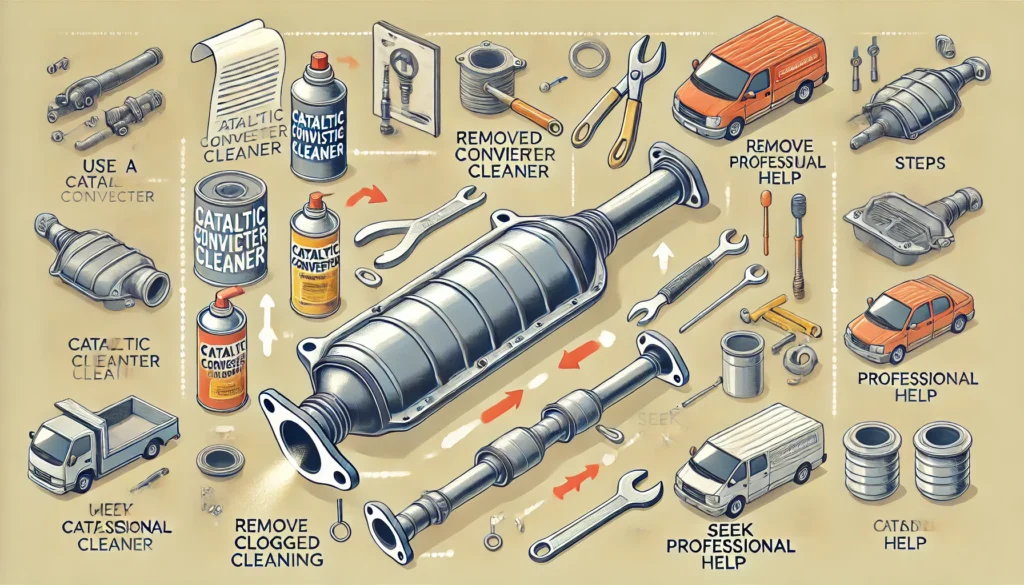If you’ve been experiencing sluggish engine performance or noticing strange smells coming from your vehicle, you might be dealing with a clogged catalytic converter. A clogged catalytic converter can significantly impact your car’s efficiency and even cause long-term damage if left unaddressed. In this blog post, we’ll guide you through the steps to fix clogged catalytic converter, ensuring your vehicle runs smoothly and remains environmentally friendly.

What Causes a Catalytic Converter to Get Clogged?
Before diving into the solution, it’s essential to understand what causes a catalytic converter to become clogged. The catalytic converter’s job is to filter and convert harmful exhaust gases into less harmful emissions. Over time, this filtering process can lead to a build-up of carbon deposits, especially if the engine isn’t burning fuel efficiently. Common causes of clogging include:
- Engine Misfires: Unburned fuel entering the exhaust system can cause carbon build-up.
- Oil or Coolant Leaks: These leaks can contaminate the catalytic converter, leading to clogs.
- Poor Maintenance: Neglecting regular engine maintenance can exacerbate the problem.
Signs of a Clogged Catalytic Converter
Knowing the symptoms of a clogged catalytic converter can help you diagnose the problem early:
- Reduced Engine Performance: A clogged converter can restrict exhaust flow, leading to sluggish acceleration and decreased power.
- Dark Exhaust Smoke: Incomplete combustion can cause black smoke to emit from the exhaust pipe.
- Check Engine Light: The vehicle’s sensors might trigger the check engine light if they detect abnormal gas levels.
- Sulfur or Rotten Egg Smell: A strong odor indicates the converter isn’t effectively processing exhaust gases.
How to Fix a Clogged Catalytic Converter
Now that you know the causes and symptoms, let’s explore how to fix a clogged catalytic converter:
1. Use a Catalytic Converter Cleaner
One of the simplest ways to fix a clogged catalytic converter is by using a catalytic converter cleaner. These cleaners are designed to break down carbon deposits and clean the converter without needing to remove it.
- Step 1: Purchase a catalytic converter cleaner from an auto parts store.
- Step 2: Pour the cleaner into your gas tank according to the product instructions.
- Step 3: Drive your vehicle for the recommended time or distance, allowing the cleaner to circulate through the exhaust system.
This method is effective for minor clogs and can improve performance without the need for mechanical work.
2. Remove and Clean the Converter Manually
For more severe clogs, you might need to remove the catalytic converter and clean it manually. This process requires some mechanical skill and tools.
- Step 1: Safely elevate your vehicle and locate the catalytic converter in the exhaust system.
- Step 2: Remove the converter by unbolting it from the exhaust pipes. Be careful not to damage any sensors or surrounding components.
- Step 3: Soak the catalytic converter in a solution of water and degreaser or dish soap to loosen the carbon deposits.
- Step 4: Use a pressure washer to remove any remaining debris. Be gentle to avoid damaging the internal components.
- Step 5: Allow the converter to dry completely before reinstalling it in your vehicle.
3. Consider Professional Help
If you’re not comfortable performing the above steps or if the clog is severe, it’s best to seek professional help. A mechanic can diagnose the issue accurately and recommend whether cleaning or replacement is the best option.
4. Replace the Catalytic Converter
In some cases, the clog may be too severe to fix through cleaning, and the catalytic converter will need to be replaced. While this is the most expensive option, it’s necessary to restore your vehicle’s performance and emissions compliance.
Preventing Future Clogs
Preventing future catalytic converter clogs involves regular maintenance and good driving habits:
- Regular Oil Changes: Keep your engine running smoothly to avoid contamination of the exhaust system.
- Fix Engine Issues Promptly: Address any misfires, leaks, or other engine problems as soon as they arise.
- Use High-Quality Fuel: Lower-quality fuel can contribute to carbon build-up in the exhaust system.
Conclusion
Fixing a clogged catalytic converter doesn’t always require a costly replacement. By understanding the causes, recognizing the symptoms, and applying the appropriate fixes, you can restore your vehicle’s performance and extend the life of your catalytic converter. If you’re ever unsure, don’t hesitate to consult with a professional mechanic to ensure the job is done right.
